Gene Engineering in Livestock Animals for the Dairy Industry
Info: 11873 words (47 pages) Dissertation
Published: 9th Dec 2019
Chapter one: Introduction
1.1 Lactation
1.2 Evolution of mammals
Monotremes
Marsupials-
Eutherians
1.3 Domestication of eutherians
Domestication of livestock
1.4 Livestock animals
Cattle
Buffalo
Goat
Sheep
1.5 Milk constituents
Milk fat
Milk proteins
Bioactive peptides
1.6 Dairy industry
Milk
Yogurt
Butter/ Ghee
Cheese
1.7 Dairy and mankind-
Future requirements of the Dairy industry
1.8 Gene editors
ZFN
TALENs
CRISPRs
1.9 Gene engineering in livestock animals
1.1 Lactation
Lactation is an essential survival strategy for all mammals to support a continuous life cycle. All the animals today share a common ancestor and a standard way of nutritional reserve. Lactation is a process of transporting nutritional reserve from mother to its infant. Over the course of lactation, a nutrient-rich fluid called ‘Milk’ is produced and secreted by the mammary gland of the lactating mother, and hence the existence of infant mammals is always dependent on the lactation ability of its mother (Oftedal, 2012), (Veltmaat et al., 2003).
Milk is natural occurring, one of the complete food produced and secreted by any animal. It provide a source of growth and energy and enhances the immunity of its recipient. Milk is formulated according to nutritional needs of an infant at a certain point. For example, the early milk/colostrum is high in antibodies and milk sugar whereas the protein and fat contents of milk increases as lactation proceeds.
The lactation period and its quantity vary from species to species. The duration of lactation differs from a few days to a few years in different mammals. The shortest lactation period is observed in hooded seals as an example of adaptive breeding. Hooded seals usually bread on unstable ice packs providing a short period to nurse its infant. The lactation in hooded seals lasts only for 3-5 days, a rapid growth of seal pups is achieved by feeding nutritional rich milk in high amount for long period of time until weaning (Bowen, Oftedal and Boness, 1985).
The longest lactation is generally seen in mammals with long weaning period. In great apes, elephants and some species of whales and dolphins lactation can last up to five years (West et al., 2007).
Similarly, the quantity of milk secreted during lactation varies greatly among species and depends on the body mass and growth requirement of infants. The body mass of Tasmanian tigers (Thylacine) is less than 40mg at birth and requires miniscule milk secretion as compared to blue whales which over the lactation period of 6 months secrets about 100,000kg milk (Oftedal, 2012).
Lactation is an exclusive power of mammals that nurtures and develops their infants, however, some species of fish and frogs exhibit similar nutritional transport behaviour suggesting some ancestral similarities between mammals, reptiles and fish.
Some species of fish like Amazonian cichlids feeds a nutritive mucous to its larvae produced by a surface mucous gland. The antibodies concentration in mucous is high in early days of secretion and decreases as larvae develop showing a similar pattern as mammals and transition of colostrum to milk as lactation proceeds (Buckley et al., 2010). Another example is a small frog (Coqui) that secretes a specialised body fluid to its eggs that providing moisture and antimicrobial proteins which helps eggs to increase in mass and is very crucial for eggs survival (Taigen, Pough and Stewart, 1984).
1.2 Evolution of mammals
Carl Linnaeus proposed the scientific classification of class Mammalia in 1758 with an emphasis on lactation being a significant feature for identification of mammals, among other common anatomical characters.
The evolutionary history of mammals dates back to the late Carboniferous period when they evolved from their ancestors, Synapsids (mammals like reptiles), about 320myr (million years) ago (Oftedal, 2012). During evolution, various traits emerged along with mammalian lineage, so these mammals were divided into different groups based on anatomical and physiological differences.
Amniotes were a clade of tetrapod vertebrates that gave rise to Synapsids and Sauropsid in the Palaeozoic period about 315myr ago. (Figure).
The Synapsids went through several evolutionary changes during Permian, Triassic and Jurassic period finally split into Prototherian and Therian mammals in the late Jurassic period. The Prototherian were the mammals with distinctive characteristics similar to reptiles leading to present day monotremes (platypus and echidna).
The Therian mammals were split 148myr ago at the beginning of Cretaceous period into two major groups, Marsupials (kangaroo, possum, koala etc.) and Eutherians (rodents and primates etc.). These two mammalian groups have different reproduction anatomy and nurturing strategy.
The marsupials have very brief gestation period as compared to placental mammals like eutherians. The other difference is the presence of an external pouch in the majority of marsupials which is used to provide nutrition and safety to infants.
The Sauropsid were split in Triassic period lading into Archosaurs (birds, crocodiles and dinosaurs) and Lepidosaurs (snakes, lizards and other reptiles) (paper, 2008).


Figure: Evolution of mammals, birds and reptiles- The emergence of present-day mammals from Synapsids in late Jurassic period (in red) and split of birds and reptiles from a common ancestor Sauropsid (in blue and yellow) (paper, 2008)
Monotremes-
The monotremes (Prototherian or Monotremeta) are a connective link between reptiles and mammals exhibiting characteristics of both classes (paper, 2008). Monotremes are oviparous/ egg-laying mammals and considered as most primitive mammals because of the similarity in the mode of reproduction with reptiles. The earliest split in mammalian phylogeny established the monotremes which separated from Theria about 166myr ago. Most members of monotremes are now extinct, except platypus and echidnas, both are found in Australia (Enjapoori et al., 2014).
The evolution of monotremes is shrouded in history due to its poor fossil records. The high-resolution X-ray computed tomography (HRXCT) of has revealed platypusas a crown monotreme and a direct relative to Theria- Monotreme split. The divergence in platypus and echidnas is calculated using strict molecular clock estimated about 17-80mya ago (Rowe et al., 2008).
Mammary gland of monotremes
Monotremes mammary gland represents the first known specialised organ to produce milk. The early lactation was probably evolved as a source of moisture to protect parchment-shelled eggs from desiccation during incubation (Oftedal, 2012). However, the role of lactation and composition of milk evolved over centuries, shifting from an egg protection strategy to a more balanced nutrient-rich fluid to nurture infants (paper, 2008).
The figure illustrates early mammary development in monotremes Echidna), the development starts with a plate-like mammary bulb/ mammary plate that generates more than 100 primary sprouts (ps) descend into mesenchyme (mm) that forms secondary sprouts (ss) at their distal ends. Each secondary sprout converts into from sebaceous gland anlagen (sga) into a mammolobular pilo sebaceous unit (MPSUs) that are fully developed and functional in the mature mammary patch. There are no nipples (Oftedal and Dhouailly, 2013).
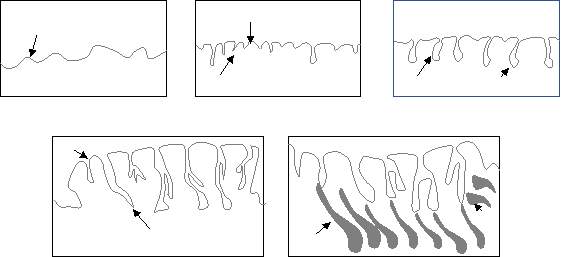
Mammary plate
Mammary plate
Mammary plate



mm


Figure: Early mammary development in echidna- The emergence of primary and secondary sprouts (ps and ss) from mammary plate and generation of mammary sebaceous gland anlagen (sga) (Oftedal and Dhouailly, 2013)
The basic structure and mode of differentiation of the mammary gland of echidna is found to be identical to marsupial and eutherian mammary gland. A comparative study of the mature mammary gland of echidna with marsupial and eutherians shows some similarities between them. For example, echidna milk patches resemble human nipple, and the diameter of alveoli and lobular structure in monotremes are identical to marsupial and eutherians (Griffiths, 1972).
Marsupials–
Marsupials (metatherians) are differentiated from the other two groups of mammals based on their lactation strategy. Marsupials are very immature at birth and usually develops inside the pouch of their mother. Within a few minutes of birth of a marsupial, it crawls into the pouch of its mother (eg. kangaroo) and attached to one of the teats (figure) (Sharman, 1970).
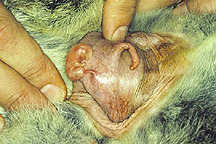
Mammary gland of a Tammar Wallaby: The infant joey is suckling from of the smaller nipples. The long nipple is still being suckled by an older joey that is now staying outside of the pouch (Nicholas et al., 2012)
The female marsupial alters the composition of milk throughout the lactation period. The level of all major components in milk changes depending on the nutritional requirements of the young. (Tyndale B and Janssens P. A 1988, the Developing Marsupial: Models for Biomedical Research)
Initially, it was believed that the mammary gland in marsupials does not differentiate from the mammary line like eutherians, but each begins as separate anlange the number varying from 2- 25 in concordance with the adult teat number for the species. (Tyndale B and rentree M 1987, Reproductive physiology of marsupials) However, recently, the mammary line was observed in trauterine in opossum embryo a few hours prior to birth. The mammary line was also found in new-born eastern quoll (Jones and Rose, 2001).
In marsupials, mammary placodes are formed by epithelial cells which upon differentiation gives rise to the mammary bulb. The development of the mammary line starts with elongation of mammary sprout in the mammary bulb. Primary sprout (ps) grows downward into mammary mesenchyme (mm). Figure
The secondary sprouting occurs by cornification of a horny plug (hp) in primary sprouts accompanied by secondary sprouting (ss) of hair (ha) and mammary gland anlage (mga). The hollowing of nipple pocket starts with the formation of sebaceous gland anlagen (sga) and growth of mammary hair anlagen. Finally, the nipple emerges with continued downward mammary gland growth. In some taxa caudal mammary anlagen develop prior to cranial anlagen. In pouched marsupials, the mammary enters a long inactive period during this phase pouch structure develops (Jones and Rose, 2001), (Oftedal and Dhouailly, 2013), (Nicholas et al., 2012).
B- Secondary sprouting
A- Elongation of primary sprout
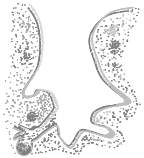

ps

hp
Mm



ha
C- Hollowing of nipple pocket
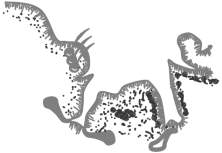
D- Nipple eversion
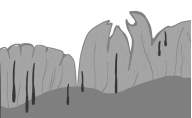

sga
np

mga
mg



ha


sc
sga
Figure: Steps of early mammary morphogenesis in marsupials- A. downward growth of primary sprout (ps) into mammary mesenchyme (mm), B. Cornification of a horny plug (hp) in the PS accompanied by secondary sprouting (SS) of hair (ha) and mammary gland anlage, C. hollowing out of nipple pocket (np), the growth of mammary hair anlagen and formation of sebaceous gland anlagen and D. nipple eversion and continued downward MG (mg) growth. (Oftedal and Dhouailly, 2013)
The lactation in marsupials starts with parturition when a clear fluid is secreted from the teats (Sharman, 1962). The early milk contains high sugar and very less fat, as the lactation proceeds the fat content up to 20% of total solids, protein content also increases with a decrease in milk sugars (Lemon M and Barker S, 1967).
kangaroo shows an interesting overlapping period of lactation, the young on foot suckles milk from one of the four teats while the infant suckles from other teats. The composition of both milks is different and secreted concurrently by separate mammary glands (Sharman and Calaby, 1964).
Eutherians-
Eutherians are the most common mammals found on earth toady exhibiting differences greatly in body size and behaviour. Diverse in size of a small shrew (15-19g body mass) to a large blue whale (140,000kg body mass) and behaviour of a domesticated livestock to terrestrial violent animals.
The important identical factors involved in such diversity are the mode of reproduction, level of metabolism and pronograde posture (Archibald, Averianov and Ekdale, 2001).
In Eutherians, the mammary gland develops till puberty in females and goes through a metabolic cycle of differentiation, lactation and involution during pregnancy. The activation of mammary gland occurs with the sexual development of females, the development of mammary gland starts at the embryonic stage and ends with involution, the cycle again starts with next pregnancy (Figure) (Hayssen and Blackburn 1985)
The activation of lactation in mammary gland by lactogenic hormones was demonstrated in rabbits in 1928 (Riddle, Bates and Dykshorn, 1933). The mammary gland development starts during embryogenesis with the formation of bilateral milk lines on 10th day of gestation (E10). These milk lines resolve into five pairs of placodes (three thoracic and two inguinal) within 24- 36 hours of its formation followed by expansion and invagination of each placode into the underlying mesenchyme to form a mammary bud. The ductal morphogenesis starts on E16 when each bud starts penetrating in the underlying mesenchyme and enters the cluster of pre-adipocytes or the mammary fat pad. Some mammary ducts sprouts from invading anlage and forms the rudimentary ductal tree that is present at the time of birth (Cowin and Wysolmerski 2010).
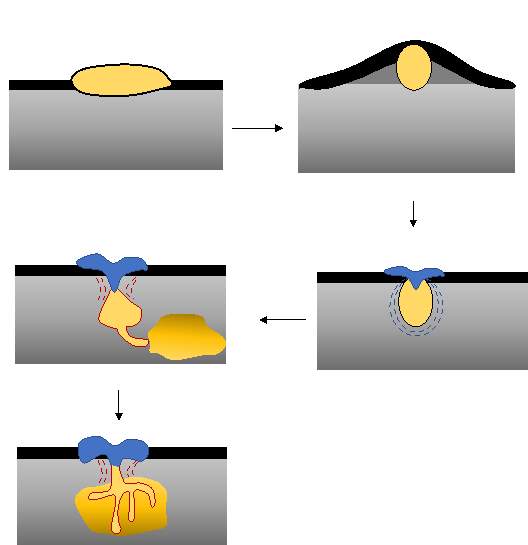
Figure: Molecular Mechanisms Guiding Embryonic Mammary Gland Development
The average length of the lactation period is shortest in eutherians as compare to monotremes and marsupials (~50 d, 675 species). The length of lactation in mammals is positively correlated to female body mass, mostly the larger species has longer lactation period with some exceptions like the earless seal and baleen whales (Hayssen, 1993).
1.3 Domestication of eutherians
Domestication is a process of taming wild animals with controlled breeding and feeding in captivity. Over the time these animals develop new traits that are not found in their wild ancestors. All domesticated animals today belong to eutherian group.
Domestication was a major turning point in human civilization as it helped co-evolution of humans and animals with a mutualistic relationship that established over an extended period of time (Zeder, 2015). Dogs were the first ever animals domesticated by humans for companionship and hunting followed by livestock.
There are different theories about the origin of domestication, Darwin (1859; 1868) considered domestication as a goal-oriented process that might have caused changes in certain body organs enables animals to achieve greater plasticity and was facilitated by a domesticator. Another point of view suggests that domestication was more of an evolutionary phenomenon. Price and King, 1968 suggested domestication as the genotypic adaptation of animals in an enclosed and controlled environment during evolution (Price, 1999). The recently coined term domestication syndrome connects docility with embryonic development with mild neural crest cell deficiency which could have resulted in the generation of domesticated animals with anatomical and physiological changes (Wilkins, Wrangham and Tecumseh Fitch, 2014).
Domestication of livestock
Sheep and goat were among the first livestock animals domesticated by humans about 10,000- 11,000 years ago (Naderi et al., 2008). The domestication of cattle was begin with now extinct wild aurochs (Bos primigenius) about 10,500 years ago. Breeding of Aurochs gave rise to much smaller Zebu cattle (Bos indicus) in Indian continent and taurine (Bos Taurus) in Eurasia. Bos indicus are distinguished from Bos Taurus by the presence of a hump, large dewlap, skin anatomy and physiological characteristics that involve adaptation to arid conditions (Bradley et al., 1998).
Water buffalo are of two types, river and swamp, and both are descendants of Babulas arnee that are believed to be developed independently from their respective wild ancestors (Kumar et al., 2007). The evidence of their domestication indicates it might have happened about 5,000 years ago in the Indus valley and Mesopotamia civilization (Cockrill, 1981). Analysis of Mitochondrial DNA collected from India, Pakistan, Egypt and Iran suggest domestication of river buffalo in Indian subcontinent prior to mature Indus Valley civilization (Nagarajan, Nimisha and Kumar, 2015).
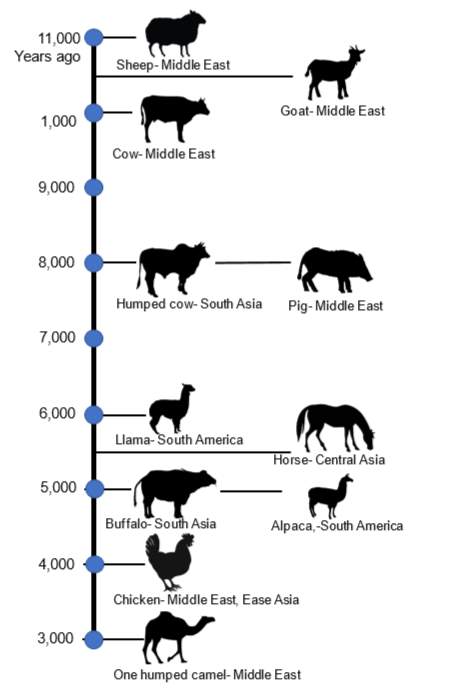
Figure: Domestication of livestock animals (http://www.collectedny.org/frameworkposts/timeline-of-animal-domestication/)
Early domestication of sheep and goat suggests that their relatively smaller size might have helped domesticator to control and tame these animals without much trouble. Goats were mainly domesticated for meat in the highlands of western Iran (Zeder and Hesse, 2000) Whereas Sheep were domesticated in western Asia for wool. Later these both animals were used as dairy animals as an additional benefit (Meadows et al., 2007). Cattle and buffalos were mainly domesticated as dairy animals whereas other animals were domesticated based on different needs, for example; domestication of horse, camel and bulls for transport.
The successful domestication of wild animals by human intervention was performed by Dmitri K Balvaev in the 1950s in Russia. The project was planned to understand origination of anatomical and physiological changes in wild animals, and if selective breeding based on behaviour trait could ultimately result in hormonal and neurochemical changes in these animals. The experiment was performed on wild silver foxes by reproducing them based on a single criterion of tameness without involving any training or medical interference. Foxes were tested for their behaviours toward human from the age of one month until puberty, the final tameness score was calculated after achieving sexual maturity. The lease aggressive foxes were bred with each other and as a control foxes with opposite behavioural traits were also bred to ensure that tameness resulted from genetic selection and not merely from experience with humans. About over 40 breeding cycles of docile foxes resulted in a group of domesticated foxes. These newly domesticated foxes were friendly toward humans and showed behavioural traits of pet dogs. Significant anatomical and physiological changes were observed like changes in coat colour, size and shape of ears, tails, skulls, jaws and teeth and lower adrenaline levels.
1.4 Dairy Livestock
Livestock are domesticated animals raised for a beneficial purpose. Milk-producing livestock animals are cattle, buffalo, goat, sheep, camel, yak and llama.
Cattle-
Dairy cattle form a unique niche among other milk-producing animals as they are the most strategically selected over centuries and bred for milk production. All cattle of the world are members of the genus Bos; they can be classified into two species Bos indicus (humped) and Bos taurus (humpless). Bos Taurus has a pronounced hump of their shoulder which probably works as an energy storage organ like other humped animals (Madalena, 2011).
The two cattle species have given rise to almost all major cattle breeds worldwide. A cattle breed can be defined as a group of animals that exhibit similar physical or genetic characteristics like size, colour or milking potential. This process usually involves human intervention and it is more rapid than a natural evolutionary process. The most popular cattle breed are-
Holstein- Friesain– Holstein are large and humpless cattle comprises over 35% dairy cattle breed worldwide. It is considered as single most important cattle breed worldwide due to its highest average milk production value of 25- 35kg per day. This breed was originated in the Netherlands and transported to the US in the 16th century. Due to their unique property of converting feed into milk proteins for human consumption (Fox, 2008), (Buchanan 2002).
Jersey– Jersey is the smallest of the dairy breed, originated from the isle of jersey in British channel. The average milk production is 16- 25kg per day. These are most popular in the arid region due to their excellent heat tolerance ability (Madalena, 2011), (Buchanan, 2011).
Guernsey– Guernsey, termed as ‘the royal breed ‘of dairy cattle was developed in the island of Guernsey. These are the second largest dairy cattle with moderate milk production of 18- 26kg per day. Guernsey are medium sized, docile cattle breed, its milk is naturally high in all milk solids and has a distinctive yellow colour due to high beta-carotene content (Madalena, 2011), (Buchanan, 2011).
Ayrshire– As the name suggests, Ayrshire breed was originated from the county of Ayr, Scotland at the beginning of 18th century. These are medium-sized humpless cattle that produces average 19- 27kg milk per day. This breed is known for high fertility, overall health and natural resistance toward mastitis (Madalena, 2011), (Buchanan, 2011).
Brown Swiss– These are brown coloured cattle originated from mountain sloped of Switzerland. Brown Swiss is one of the oldest dairy breeds in the world. These are among a few dairy breeds that are used in the beef crossbreeding program due to their more massive muscles body. Brown Swiss has the production value of 21- 29 kg per day (Madalena, 2011), (Buchanan, 2011)
Buffalo–
The domestication of water buffalo occurred in the Indus and Yangtze valley civilisation about 5000 years ago (Cockrill, 1981). It is the second largest milk producing ruminant in the world. Contributing to 11.1% of the world milk production in 2006- 2009, mainly in south Asian countries.
(FAO STAT 2012)
Buffalo milk contains more than twice as much fat as compared to cattle’s milk. Water buffalo have historically been divided into swamp and river buffalo based on their morphological, behavioural and geographical criteria.
River buffalo– These are found in the Indian subcontinent, southwest Asia and Mediterranean countries, mainly used for milk production (Han et al., 2007).
As the name suggests, river buffalo wallow in clear and running River. Their milk yield is about 6-7 kg per day. The main river buffalo breed of India and Pakistan are Murrah, Surti, Nagpuri, Mehsana and Jarrarabadi (Chantalakhana, 2000).
Swamp buffalo– These are low milk yield about 1- 1.5 kg per day, mainly found throughout South Asia and China. Swamp buffalo are primarily used as drought animals (Talpur et al., 2008) that prefers to wallow in stagnant water pools and mud holes (Chantalakhana, 2000), (Subasinghe, 1998).
Goat- Goats were domesticated about 10,000 years ago in southwest Asia, during the same period and region as sheep (Groeneveld et al., 2010). Goat milk accounted for 2.4% of global milk production in 2010 (FAO STAT 2012). India is the leading producer of goat milk (30%) followed by Bangladesh (17%) and Sudan (11%). Goats are easy to rear due to their small size and adaptability. Goat farming is prevalent in the arid and semi-arid region; it is widely carried out in South Asia, west and central Africa. Genetic selection and breeding programs have resulted in high yield and more extended lactation period. Plant oil supplement can improve quality of goat milk. (chillard et al 2015). The average milk production is about 2.5- 3.5 kg of milk per day and about 140 kg per year.
The goat milk is considered easy to digest as compared to cattle milk due to the presence of smaller fat globules (raynal, ljutovac 2008). The goat milk composition is similar to cattle milk with equal protein and fat content it has high retinol and free amino acids but is lower in vitamin B12 content.
In rural areas, on-farm consumption of goat milk is very high. Although goats are considered as ‘poor man’s cow’ but they cannot be associated with under development or poverty as goat farming is economically significant in some Mediterranean countries where goat milk is used to make cheese and yoghurt (Boyazoglu, Hatziminaoglou and Morand-Fehr, 2005).
Sheep– Sheep is considered one of the earliest livestock animals, domesticated about 12,000 years ago in southwest Asia (zedar 2006). Dairy sheep account for a total of 1.3% of world milk production. About 61% of the world’s sheep milk is produced in the Mediterranean region and mainly used for the production of cheese and other dairy products. (FAO 2012). Sheep milk contains 5.6g/ 100 g protein and 6.4g/ 100 g fat that is higher than cattle’s milk. The lactose and retinol content in sheep milk is higher than other milk producing livestock animals which are compensated by lower sodium and potassium levels. (FAO)
The genetic selection of dairy sheep has not resulted in any significant improvements in milk yield or lactation lengths; as a result, the use of dairy sheep is minimal since they do not hold significant commercial value.
Other dairy livestock-
Other milks producing livestock animals are the camel, moose, reindeer, mithun, donkey, llama, alpaca, and yak. These are mostly milked in specific regions throughout the world where these animals are found in abundance. These kinds of milk are usually produced and consumed on-farm and not preferred in large-scale dairy industries due to limited availability.
Camel milk is mostly consumed in the arid region of Africa, Mediterranean and Asia, reindeer and moose milk in northern Scandinavia and eastern Siberia, yak milk is consumed in the mountainous area of Asia whereas llama and alpaca milk in South America. The concentration of milk components varies significantly in these animals.
The composition of camel milk is very similar to cattle milk, however, the absence of beta lactalbumin, and high beta casein concentration makes it more like human milk. Camel milk is considered to have several medicinal properties due to higher amounts of bioactive substance and antimicrobial components like lysozyme, lactoferrins and immunoglobulins. Reindeer and moose milk are very high in fat and proteins and has cream like consistency whereas lactose concentration is low in both reindeer and moose, containing nearly half the value found in cattle milk. Yak milk has high-fat content that is much higher than human and cattle milk but more similar to buffalo milk. Beta lactalbumin content of yak milk is twice as much as in cattle milk. Llama and alpaca were not initially bred for dairy purposes. Due to limited research and awareness, the information on milk concentration is most scarce.
1.5 Milk constituents
Milk contains all essential elements that provide a balanced diet to an infant required for its growth, development and immunity.
Although the general composition of milk is similar in livestock, the concentration of milk constituents varies among species. (Table- FAO) Despite the differences, milk exhibits common components like caseins, whey proteins, milk fat and lactose.
The composition of milk is directly affected by stage of lactation. In the first few days, the mammary gland produces colostrum that is high in carbohydrates and immune factors which change as lactation proceeds and colostrum turns into the milk. The other factors that have a significant impact on milk composition are quality of animal feed and type of breed. (REF- FAO, Mesfin and getachew 2007).
| Water | Protein | Fat | Lactose | |
| Human | 87.5 | 1.0 | 4.4 | 6.9 |
| Cattle | 87.8 | 3.3 | 3.3 | 4.7 |
| Goat | 87.7 | 3.4 | 3.9 | 4.4 |
| Buffalo | 83.2 | 4.0 | 7.5 | 4.4 |
| Sheep | 82.1 | 5.6 | 6.4 | 5.1 |
| Mouse | 75.4 | 9.0 | 13.1 | 3.0 |
Table: Composition of milk from different species (in g/100g milk)
Milk fat
Milk fat is an excellent source of energy and essential fatty acids for mammals. It carries crucial fat-soluble vitamins like vitamin A, Vitamin and vitamin D along with anti-cancer, anti-microbial and anti-inflammatory properties (German and Dillard, 2006). Milk fat is highly complex, consisting of a large number of fatty acids and other lipid molecules. Its concentration in milk varies from 0.2 g/100g of milk in the donkey to 16.0 g/100g of milk in reindeer. The synthesis of fat during lactation in the mammary gland is a highly controlled process, the genes and biochemical processes involved appear to have evolved under the constant selective pressure of mammalian infant nutrition (German and Dillard, 2010).
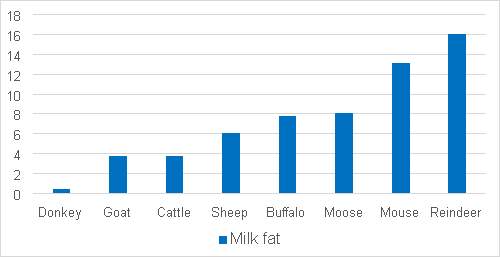
Table: The Fat content of milk from different species (in g/100g milk)
Milk proteins-
Caseins
Caseins and whey proteins are two primary group of milk proteins. Caseins account for ~80% of total milk proteins; these are a cluster of proteins expressed by casein locus in mammals. Mammary epithelial cells secrete milk proteins in a polarised manner from their apical surface during lactation. Milk proteins are majorly synthesised in mammary epithelial cells and packed into secretory vesicles and released from the cells by exocytosis using a secretory pathway (Franke et al., 1976), (Burgoyne and Duncan, 1998). The protein concentration of milk varies significantly between species as shown in the table.
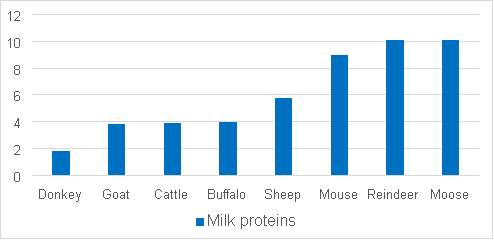
Table: The protein content of milk from different species (in g/100g milk)
Whey proteins
Whey proteins in milk comprise several proteins like alpha-lactalbumin, Beta- lactalbumin (BLG), whey acidic proteins (WAP), lactoferrin (LF) and immunoglobulins. Some proteins like alpha-lactalbumin, BLG and WAP are synthesised in mammary epithelial cells whereas LF and immunoglobulins are transferred directly from the blood. Not all whey proteins are expressed in mammals, for example, BLG does not express in humans but cattle and sheep.
Alpha-lactalbumin-
Lactose is a milk sugar found in a large number of mammalian species. The production is milk lactose is regulated by alpha-lactalbumin (Brodbeck and Ebner, 1966). Colostrum usually contains high concentration of lactose as it is an essential energy source for infants in all mammalian species however the alpha-lactalbumin expressing gene (lalba) is poorly expressed in fur seal which has high milk fat content to increase body mass of seal pups, required for their survival (Sharp, Lef??vre and Nicholas, 2008).
The regulation of Alpha-lactalbumin is controlled by lactogenic hormones like prolactin and insulin during the last phase of gestation and early stage of parturition (Robinson et al., 1995), (Nicholas et al., 1997). Lactose concentration in milk varies in species as shown in the table.
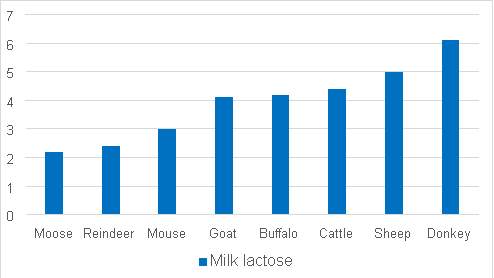
Table: The lactose content of milk from different species (in g/100g milk)
Beta lactalbumin (BLG)
BLG is the most abundant whey protein in the milk of most mammals, accounts for about 50% of total whey proteins and 10% of total milk proteins (Creamer, Loveday and Sawyer, 2011). BLG is mainly found in the milk of ruminants but is also present in the milk of other species with exceptions like human, rodent and rabbit (Kontopidis, Holt and Sawyer, 2004). However, unlike alpha-lactalbumin, BLG does not have any identifiable function in mammals (kontopedis holt 2004).
Bovine BLG usually exists as a dimer and shows resistance toward acid hydrolysis and proteases. Due to these properties, this protein remains intact after digestion and acts as an antigen (Tsabouri, Douros and Priftis, 2014). The antigenic property of BLG results in the intestinal allergic reaction like diarrhoea in infants (Gall et al., 1996). Recently BLG KO goats were produced using CRISPR/Cas9 technique. These goats resulted in a very slight drop in total protein concentration and secretion of more humanised milk (Zhou et al., 2017).
lysozyme
Lysozyme is found in many body fluids like saliva, tears and milk of all mammals including human. It is a naturally occurring immune protein that causes bacterial lysis by breaking peptidoglycan links present in the bacterial cell wall (Masschalck and Michiels, 2003). The genetic organisation of lysozyme shows over 40% similarity with alpha-lactalbumin expressing gene lalba.
The concentration of lysozyme in milk differs majorly in species; human milk contains 400 ug/ml lysozyme whereas cow and goat’s milk contains 0.13 ug/ml and 0.25 ug/ml lysozyme. Due to potential antibacterial effects and shallow concentration of lysozyme in ruminant’s milk, human lysozyme was expressed in goat’s milk that resulted in an improvement in milk’s antibacterial activity (Carneiro et al., 2018).
Whey acidic proteins (WAP)
Whey acidic protein is a significant whey protein found in rodents, camel and pigs. It is partially present in platypus and echidna but absent in human, cattle and sheep (Demmer et al., 2001). Mouse WAP are small cysteine-rich, acidic proteins that show homology with protease and ATPase inhibitors by sharing a conserved domain called four- disulphide code (4-DSC), and therefore mouse WAP has been classified as a protease inhibitor. The WAP gene is expressed in the mammary gland of mouse, rabbit and pig at late pregnancy and throughout lactation (Hennighausen and Sippel, 1982). The deregulation of WAP in mouse showed impaired mammary development, and thus WAP was initially considered as an essential factor in terminal differentiation and maturation of mammary alveolar cells (Burdon et al., 1991).
Although, knockout mouse lacking both alleles of WAP gene resulted in healthy pregnancy and mammary gland differentiation the pups feeding on WAP knockout mice were malnourished especially during the late phase of lactation. These observations suggest that WAP is not essential for mammary development but required for adequate nourishment of pups (Triplett et al., 2005).
Lactoferrin (LF) and transferrin (TF)
These milk proteins are not synthesised in mammary epithelial cells but transported by blood directly into the mammary gland. LF was first reported in the 1940s as a red protein fraction of human milk. The subsequent studies of LF showed many similarities with a serum iron-binding protein TF.
LF and TF both are iron binding antimicrobial proteins that play a role in iron absorption (Brock, 1980). The concentration of LF and TF varies in mammals, TF and LF both are secreted in the milk of mouse, horse, cow, goat and pig whereas rat and rabbit milk contains TF only. LF in the mouse is considered as a significant estranged inducible protein that is upregulated during involution and is in abundance during the last phase of lactation (Pentecost and Teng, 1987).
LF and TF share many structural and functional similarities including 3D structure and iron binding sites, but these can be differentiated based on their physiological origin and iron binding capacity. TF is synthesised in the liver and served in plasma where it transports iron and delivers it to cells (Baker, Baker and Kidd, 2002). Whereas LF is synthesised by glandular epithelial cells and neutrophils in extracellular fluids. It is present in milk, tears, saliva and airway mucus where it takes part in the natural immunity of the body (Peterson et al., 2000).
Immunoglobulins
In many mammalian species, milk Immunoglobulins are a primary source of antibodies that form an immunological link between mother and the infant (Barrington and Parish, 2001).
Immunoglobulins are found in abundance in colostrum; its concentration becomes steady with the progression of lactation. IgG is the primary immunoglobulin found in colostrum and milk. In human, maternal blood is in direct contact with the foetus by the hemochorial placenta, in this case, immunoglobulins directly get transported from mother to embryo. In animals with the cotyledonary, epitheliochorial and endotheliochorial placenta, immunoglobulins cannot cross the placenta during pregnancy, so the only way for transfer is via lactation. Infant claves that suffer failure in passive transfer of maternal IgG show dramatically high mortality rate during the first few days and weeks of life with increased risk of diseases (Van De Perre, 2003).
Bioactive peptides
Milk contains several health-promoting bioactive peptides listed in the figure. Biologically active peptides can be produced from milk by fermentation, proteolysis or enzymatic hydrolysis.
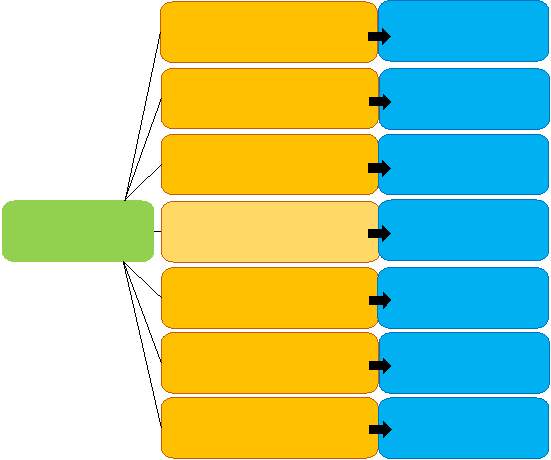
Figure: List of milk protein derived bioactive peptides and their potential health benefits
These bioactive peptides improve dental, digestive, bone and heart health and could control stress and improve memory and immune system. The other function includes reduction of obesity and type II diabetes (Korhonen, 2009).
1.6 Dairy industry
The first agricultural revolution in human history started 10000BC ago followed by the domestication of cattle in 8000BC; these events turned out to be the major turning point in human civilisation.
In the next few centuries, different more animals were domesticated, and milking animals were transported across countries. The first large-scale milk production started in the USA in the mid-18th century. However, the establishment of dairy industries began only after the discovery of pasteurisation by Louis Pasteur in 1864. It was a major milestone in the establishment in cattle farming and dairy industries. The process increased the shelf life of milk and decreased the risk of potential milk contamination facilitating production of dairy products like yoghurt, cheese and butter. Pasteurisation of commercial milk was made mandatory in 1917.
During the same period, sophisticated dairy machines were invented which increased production of dairy products by the late 20th century. The dairy has improved majorly in the past few decades; high lactating dairy cattle breeds have been developed using well-planned breeding programmes.
The research on livestock milk started in the late 19th century to explore the possibilities to improve milk quality. In the year 2008, Consumption of cloned milk was approved in the USA by the Food and Drug Administration (FDA).
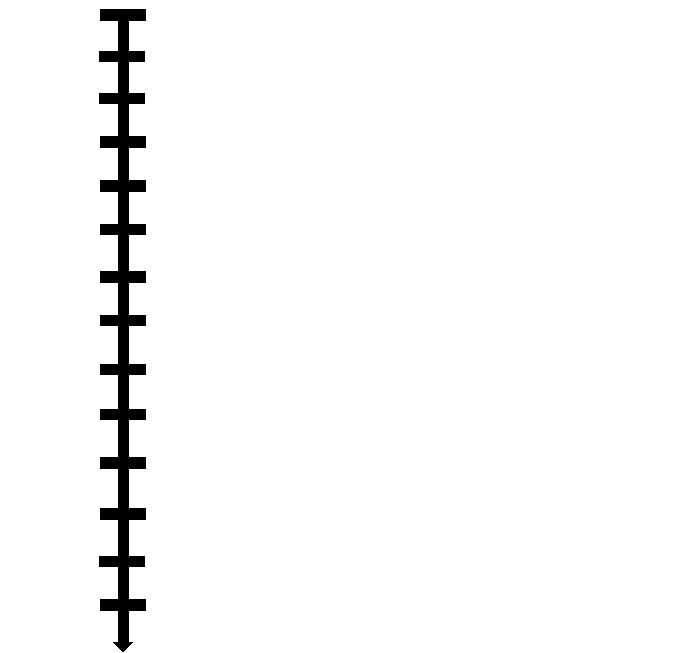
Timeline: Domestication and spread of livestock and establishment of dairy industries
Milk
Raw milk is the starting dairy material that can either be consumed directly after pasteurisation or can be used for the production of value-added dairy products. In dairy industries, milk is usually classified according to its fat content, for example, whole milk, semi-skimmed milk or skimmed milk. Out of all milk-producing livestock, cattle milk is most produced and used in dairy industries. In 2013, over 85% of cattle milk was produced followed by 11% buffalo milk, 2% goat milk, 1% sheep milk and 0.4% camel milk. India was the biggest producer of milk with the total of 18% of total dairy worldwide in 2013.
The production of milk has increased every year. In 2015, more than 800 million tonnes of cattle milk was produced worldwide as compared to over 700 million tonnes in 2005. Similarly, production of buffalo and other milks has also been increasing over the years globally. (Figure)
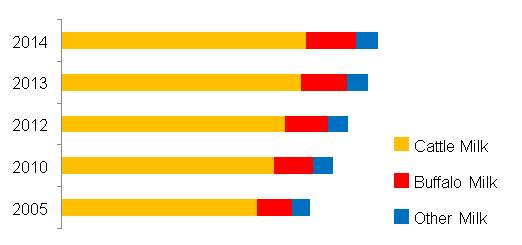
0 200 400 600 800 1000
World milk production by species in 2013 (in Million Tonnes) (Summit daily, Sept 2015)
https://www.fil-idf.org/wp-content/uploads/2016/03/Summit-Daily-Issue-2.pdf
Yoghurt
Discovery of yoghurt is believed to be spontaneous by accidental exposure of raw milk to lactic acid producing bacteria. The evidence suggests its invention about 5000BC in central Asia (Alvarez, 2009).
Yoghurt is a fermented milk product that is produced by acidification of milk. Lactobacillus forms lactic acid from milk sugar lactose and coagulated caseins.
Unlike butter and fat, yoghurt production does not result in loss of any milk nutrient. Yoghurt is very rich in nutrients and usually associated with several health benefits. It is abundant in essential amino acids, calcium, vitamin B, zinc and probiotics (El-Abbadi, Dao and Meydani, 2014). The first industrialised production of yoghurt started in Europe (Barcelona, Spain) in 1919 by Isaac Carasso. In the united stated, yoghurt industry was set up in the 1940s by Issac’s descendants. Health benefits of yoghurt included in the prevention of cardiometabolic diseases and associated with body weight loss (Astrup, 2014) and prevention of type 2 diabetes (Gijsbers et al., 2016), (Fisberg and Machado, 2015).
The worldwide production of yoghurt has increased from 30.3 million tonnes in 2010 to 40.7 million tonnes in 2015. China is the leading producer of yoghurt with 3.6 million tonnes in 2010 and 6.0 million tonnes in 2015 (world yoghurt market report, 2013). Yoghurt consumption is one of the indicators of economic growth in developing countries. For example, yoghurt consumption in Brazil has increased more than 7-fold between 1974 and 2003.
Butter/ Ghee
Butter was first discovered in ancient Africa around 8000 BC whereas Ghee has been produced in South Asia since 1500BC (Acharya 1997), (Sserunjogi, Abrahamsen and Narvhus, 1998). Buffalo milk is usually preferred for butter production due to its high fat concentration.
Indian ghee is made mainly from cattle and buffalo milk whereas in the Mediterranean it is produced by goat sheep and camel milk (Narvhus et al., 1998).
Traditionally butter was made by hand until the 18th century, the industrialisation of butter began in Europe with the invention of the mechanical cream separator by Carl Gustaf Patrik DeLaval in 1876. The machine used centrifugal force to separate milk and cream. The large-scale commercial production of butter in the USA started in 1882 with a similar cream separator.
Butter and ghee are water in oil emulsion with very high-fat content. The process involves the separation of cream from milk that produces butter by churning milk cream. Butter contains up to 80% butterfat whereas ghee contains up to 99% butterfat and very low moisture content. (FAO) Butter has a saturated fat content around 51.4% such as palmitic and stearic acid and unsaturated fatty acids like palmitoleic, Oleic, Linoleic, Linolenic acids. Butter also contains essential and non-essential amino acids, most of the vitamins and minerals like calcium, magnesium, and potassium (Kwak, Ganesan and Mijan, 2013). Ghee contains significant amount of fat-soluble vitamins that include vitamin A, vitamin D, and vitamin E. The shelf life of ghee is up to 2 years.
India is the primary producer of butter and ghee. In 2014, worldwide butter and ghee production were 21.1 million MT. The consumption of butter is increasing gradually with 8.6 million MT in 2010, expected to reach 11.23 million MT by 2020 (world butter market report, 2000-2020).
Cheese
Cheese making can be termed as an emergence of dairying in prehistoric societies, enabling the production of a food alternative without slaughtering livestock animals (BOGUCKI, 1984). Due to insufficient documentation, the origin of cheesemaking is unclear, but the written evidence suggests that cheese was made and consumed by mid-third millennium BC (Hallo, 1972). First industrial production of cheese started in 1915 in Switzerland, followed by the USA in 1851.
Cheese is made mainly from caseins, and thus it is a significant source of calcium. Production of cheese is a process of milk coagulation either enzymatically or by acidification, results in separation of proteins (mainly casein) and fat from the water. This makes a semi-solid curd which is converted into cheese by straining of liquid whey (Gouin, 1997).
The process makes cheese easy to digest by breaking down casein. 90% of the milk component is water that appears while cheese making, about 10 litres of milk is required to make 1kg cheese. Although only about 75% of proteins are recovered in this process, remaining proteins are lost with whey separation (Henning et al., 2006), (Wigertz, Svensson and Jägerstad, 1997), (Kongo and Malcata, 2015).
Cheese is high in protein and fat, and low in lactose, cheddar and parmesan cheese are highest in protein and fat content with >30 g both in 100 g of cheese. Remaining is water that is about 30-40% (FAO). Milk coagulation lowers the pH that results in loss of calcium, phosphorus and decreases zinc, potassium and magnesium content. Vitamin content of cheese involves vitamin A, riboflavin, folate and vitamin B12. Goat cheese is usually high in vitamin B6 and folate, which could be due to lactic acid bacteria or yeast (Raynal-Ljutovac et al., 2008), (Lucas et al., 2006).
There are about 1,400 verities of cheese in the world, and more than 50% world cheese are produced in Europe followed by America. The global sale of cheese is about $80.5 billion worldwide; it is expected to rise by $110.5 billion in 2021 (https://www.statista.com/statistics/602542/cheese-market-value-worldwide/)
1.7 Dairy and mankind
Dairy industries have dramatically grown in the past few decades. Milk and milk products have become a vital part of the daily meal of majority of world population. The global sales of dairy products have reached over $600 billion which plays a crucial role in the world economy.
The production of cattle, buffalo and other milk has dramatically increased in the past one decade. It contributes about 27% of global value added of livestock and 10% of agriculture. The world milk production has an average annual growth rate of 1.8% and is predicted maintain this rate in the next ten years. With a continually growing world population, the demand for food sources is also increasing. It has been predicted that 69% more food will be required by 2050 to feed an estimated world population of 9.6 Billion (World Resources Institute, 2013). The figure shows current per capita consumption of fresh and processed milk products in major parts of the words and its forecasted increment by the year 2027. The elevation in dairy requirement is a clear indicator of growing need of improved global dairy in the near future.

Figure: Current and predicted per capita consumption of processed and fresh dairy products in milk solids (in kg) FAO
Food security and Malnutrition- Milk is a nutrition rich food provides proteins, calcium and vitamins. It can be used in controlling malnutrition in pregnant woman and children and also mainly in underdeveloped countries. Dairy is the third largest provider of proteins and fat and fifth largest provider of energy in humans. (FAO). More affordable and efficient dairy could play a crucial role in ascertain malnutrition.
Livelihood and Employment– About 28% of the world population is directly or indirectly employed by agriculture. Dairy animals are mostly owned by farmers worldwide that provide them with a guaranteed source of food and livelihood. Dairy also supports woman empowerment, about 80 million women worldwide are engaged with cattle farming (FAO)
About 13,000 dairy farms have generated a total of 28,000 full-time jobs in the UK. In Australia, 6,200 dairy farms created 39,000 full-time farm jobs. The 736 Chinese dairy farms employed over 270,000 people.
Overall, approximately 240 million people are directly or indirectly employed in the dairy industries by an estimated 150 million cattle farms globally (DEFRA, 2016), (Dairy Australia 2015), (IBIS World 2016), FAO stat.
Future requirements of the Dairy industry
The dairy industry is projected to grow significantly in the next few decades with the global establishment of advanced dairy farms in all major countries in the world. An understanding of milk regulation in mammals could help in fulfilling current requirements of dairy industries like-
- Generation of high yielding cattle
- Production of milk with an increased shelf life
- Creation of milk with a tailored composition for specific dairy product production- e.g. high casein content for cheese production and high-fat content for butter/ ghee production.
Dairy industries can be improved by using genetic engineering approaches. In the past two decades, the different components of milk like caseins, alpha-lactalbumin, BLG and fat have been investigated using different experimental methods. However, recently discovered gene editing techniques especially CRISPRs could help in achieving above mentioned dairy requirements.
1.8 Gene editors
Gene editors are the tools that allow manipulation of DNA by insertion, deletion or replacement of a single base to megabase pairs to alter the genome, the technique is called gene editing/ genetic engineering. Over the years, there are several advancements in the gene editing techniques; new methods have been that allows DNA targeting with high precision and low time investment.

Figure: Gene editing and repair of targeted DNA
Gene editors like Zinc finger nucleases (ZFN), Transcription activator-like effector nucleases (TALEN) and newly discovered Clustered Regularly Interspaced Short Palindromic Repeats (CRISPRs) are highly competent in achieving gene editing with no off-target effects. Out of these three gene editors, CRISPRs are considered the most efficient, time and cost effective.
All gene editors create a double-stranded break (DSB) in the targeted DNA strand (figure). The DBS can then be repaired according to the expected outcome.
To knock- out a gene, a disruption in DNA sequence is made by creating a DBS, and the DNA get repaired using non-homologous end joining (NHEJ), losing the targeted DNA. Similarly, a desired gene/ piece of DNA can be deleted using two gene editors and which then get repaired by NHEJ.
To create a knock-in, DSB is created and a repair template is provided for homology-directed repair (HDR). This incorporates desired DNA into the target.
Zinc finger nucleases (ZFN)
ZFN was the first programmable gene editing tool used. These are protein-based molecular scissors that cut DNA with high specificity. ZFN comprises two domains, a DNA binding domain and another DNA cleaving domain that facilitate targeted editing (figure). The DNA binding domain recognises a 6bp target sequence which is then cleaved by FokI nuclease domain (figure)
The nuclease activity of zinc finger peptides was identified in the early 1990s (Giel et al., 1993). The zinc finger DNA binding motif occurs in many proteins that regulate eukaryotic gene expression. The crystal structure of Zif268 (zinc finger protein 225) helped in understanding DNA recognition by these proteins and provided a way to engineer novel DNA binding motifs (Pavletich and Pabo, 1991), (Gersbach, Gaj and Barbas, 2014).
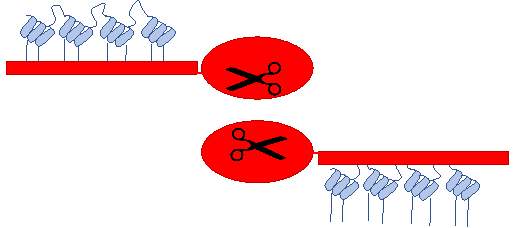
Figure: Zinc finger nucleases
Zinc finger domains form a simple ββα structure that folds around a central zinc ion, making contact with adjacent 3–4 base pairs along the major groove of the DNA (Pavletich and Pabo, 1991), (Lee et al., 1989), (Pabo, Peisach and Grant, 2001). The technique was further developed by generating a library of zinc finger targeting domains using approaches like phase display system, sequence-specific DNA recognition and random mutagenesis to alter binding specificity of Zif268 (Rebar and Pabo, 1994), (Choo, 1995), (Jamieson, Kim and Wells, 1994). The benefits of ZNF includes their compatibility in a variety of mammalian somatic cell line, and the mutations are permanent and heritable
.
Transcription activator-like effector nucleases (TALENs)
Genome editing with engineered nuclease became more efficient with successful DNA editing using TALENs in 2011 (Miller et al., 2011), (Zhang et al., 2011). TALENs are restriction enzymes that can be engineered to mutate a target DNA sequence. These are protein-based gene editors; the TAL effector nucleases are derived from a plant bacterial pathogen Xanthomonas. Which is a group of gram-negative bacteria that infect more than 200 different plant families (Boch and Bonas, 2010).
The DNA binding domain of TALENs is composed of 33-34 amino acids repeats that recognises and binds to the target DNA. This domain can be engineered to bind nearly any sequence in the genome. The other part, the nuclease cuts the DNA which can be repaired either by NHEJ or HDR (Moscou and Bogdanove, 2009). (Figure)
FokI cleavage domain

Binding domain
Figure: Transcription activator-like effector nucleases
The cutting activity of TALEN was initially used to edit target genes in cultured human cells, human pluripotent cells, in somatic zebrafish cells, nematode species (Miller et al., 2011), (Hockemeyer et al., 2011), (Sander et al., 2011) (Wood et al., 2011). However, the technique has improved over the years, and successful gene editing in livestock like pig, cattle and sheep has already been achieved (Carlson et al., 2012), (Lillico et al., 2013), (Proudfoot et al., 2015).
TALEN are highly efficient, and there is no target site restriction, however, minor off-target effects have been observed in some targeted cell lines.
Clustered Regularly Interspaced Short Palindromic Repeats (CRISPRs)
CRISPRs are the most recent addition in genome editing tools. The discovery of CRISPRs has led to the expansion of gene editor family as it provides a reliable alternative to previously discovered nucleases. It is a prokaryotic immune system that has been engineered to mutate eukaryotic genome.
CRISPR/ Cas9 is an RNA guided nuclease system for targeted introduction of a double-stranded break in DNA. It was initially discovered in bacteria as an acquired defence against pathogens. CRISPR/ Cas9 system contains a guide RNA (gRNA) and Cas9 enzyme (Figure). The gRNA comprises ~20bp target sequence upstream of a protospacer adjacent motif (PAM). The PAM directs the Cas9 nuclease to introduce a double-stranded break in the target site. The DSB can then be repaired either by non-homologous end joining (NHEJ) or by homology-directed repair (HDR). CRISPRs are simple, cost-effective and have been successfully tested in all common model organisms.
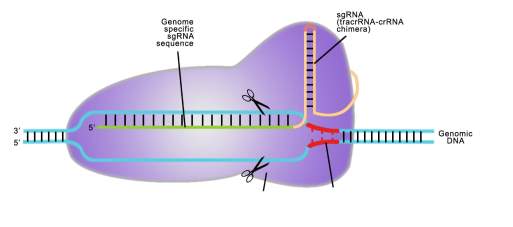
Figure: Clustered Regularly Interspaced Short Palindromic Repeats (CRISPRs)
The function of CRISPRs was discovered in 2002, however, in the next one decade several discoveries were made until successful editing of human and mouse cells in 2012 (Jansen et al., 2002), (Jinek et al., 2012)
The figure shows a timeline of the discovery of CRISPRs as a gene editing tool and advancements in this technique. In the past few years, a variety of CRISPRs function has been demonstrated. The possibilities of making edited mosquitoes that are a poor host for malaria pathogens and curing HIV using CRISPRs have been shown.
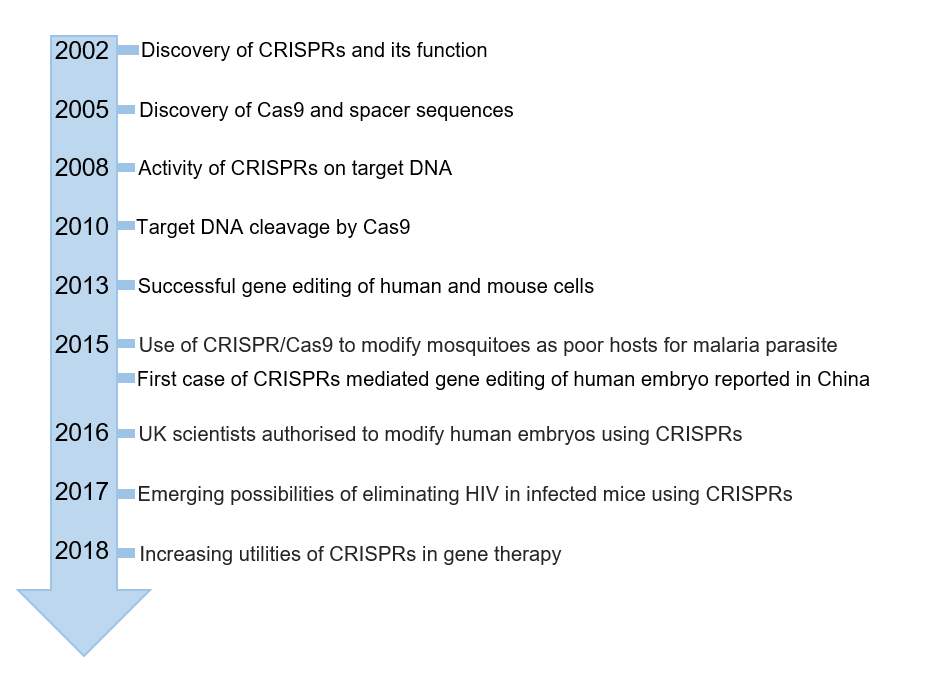 Figure: timeline of the development of CRISPRs and its advancements (ref)
Figure: timeline of the development of CRISPRs and its advancements (ref)
1.9 Gene engineering in livestock animals
The generation of first transgenic livestock in 1985 paved the way to genetically improve farm animals using genetic engineering techniques (Hammer et al., 1985). The possibilities of expressing proteins of interest in livestock animals using genetic engineering techniques in place of using microbial production system were firstly highlighted about three decades ago. The use of transgenic livestock as a bioreactor to express human proteins like insulin, plasminogen activator, alpha-1 antitrypsin, and coagulation factors VIII and IX in the milk was discussed broadly in the past (Clark et al., 1987).
Subsequently, the use of mammary gland of large farm animals like pig, sheep, goat and cattle to express therapeutic proteins in milk was reviewed (Jänne et al., 1992). The gene modifier tools like TALENs and CRISPRs with precise genome editing ability have broad applications and promises efficient gene editing. Myostatin gene (growth differentiation factor 8), a negative regulator for muscle growth in bovine and ovine was successfully targeted using TALEN mRNA in sheep and cattle (Proudfoot et al., 2015). Large segments of DNA was deleted by using CRISPRs; a guide RNA was designed to aim hypoxanthine phosphoribosyl transferase (HPRT) gene of human embryonic kidney (HEK293FT) cells that resulted in the deletion of DNA fragments from a few base pairs up to 1MB (He et al., 2015). These results show that these new techniques are not limited and can be applied to various livestock animals to target different size of gene segments.
Mammary glands have always been a preferred organ for biomedical applications in transgenic livestock animals because of the feasibility to produce large quantity of proteins and availability of established methods for extraction and purification of these proteins.
Alteration in milk composition started in 1987 when beta lactalbumin from sheep was successfully expressed in the mammary gland of mice during lactation (Simons et al., 1987). Multiple drugs and proteins have been produced in mammals over the last decade. Antithrombin III is a therapeutic protein which has been produced recombinantly in the in the mammary glands of transgenic goats and has been used treat heparin-resistant patients (Kues & Niemann, 2011). α glucosidase from the milk of transgenic rabbits has been successfully used for the treatment of Pompe’s diseases (Van den Hout et al., 2001). Milk composition was enhanced by adding extra copies of bovine beta and kappa casein in cows which resulted in a nearly double concentration of Beta and kappa casein in transgenic cow (Brophy et al., 2003). Whey acidic protein genes from mice were expressed in pigs to check their function across species and resulted in higher level of WAP in pig’s milk (Wall et al., 1991). Transgenic goats expressing human lysozyme, an antimicrobial enzyme, were produced to enhance the antimicrobial properties of milk (Maga et al., 2006). Later it was demonstrated that the milk containing antibacterial proteins like lactoferrin and lysozyme could reduce mastitis in cows and improves digestion in piglets (Cooper et al., 2013) (Cooper et al., 2014). Myostatin is a protein produced by myocytes, it is encoded by MSTN gene and has a role in the inhibition of muscle growth and development. MSTN knockout sheep were successfully produced using CRISPRs to promote their muscle growth (Crispo et al., 2015). These examples implicate that the advances in farm animal transgenesis is gaining momentum and are being successfully applied to the production of therapeutic proteins in the last few decades.
Cite This Work
To export a reference to this article please select a referencing stye below:
Related Services
View allRelated Content
All TagsContent relating to: "Farming"
Farming is the business or activity of working on a farm. Farming activities include ground preparations, sowing or planting seeds, tending crops, or activities involved in the raising of animals for meat or milk products.
Related Articles
DMCA / Removal Request
If you are the original writer of this dissertation and no longer wish to have your work published on the UKDiss.com website then please:




